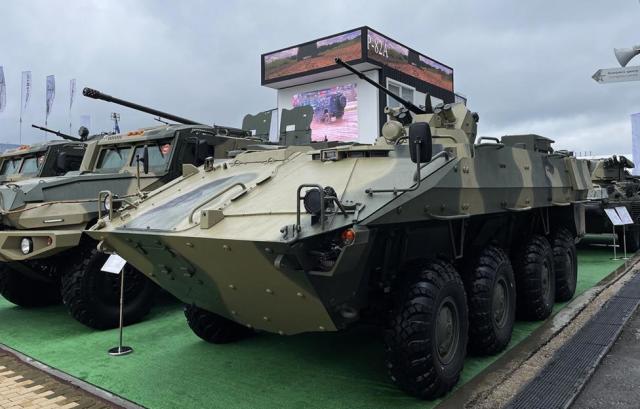Russia’s VPK (Military Industrial Company) unveiled a novel 8×8 platform during the recent Army-2023 exhibition near Moscow in early August. Contrary to initial assumptions, the vehicle showcased under the BTR-82A (Advanced) moniker is not an upgraded rendition of the well-known BTR-82 platform; rather, it emerges as a completely fresh design.
VPK embarked on the creation of the BTR-22 as an independent endeavour, aiming to provide a more cost-effective and simpler-to-manufacture alternative to the Bumerang 8×8 armoured personnel carrier. The experimental vehicle, officially named the BTR-22, was conceived as a VPK initiative and is presently undergoing trials within the Russian Army.
As noted in the materials of the Military-Industrial Company, the updated eight-wheeled APC is designed to accommodate 10 people, is equipped with a 330 horsepower YAMZ 536 diesel engine and can accelerate up to 80 km/h on the highway. The main weapon of the novelty was a 30 mm 2A72 cannon. The armour of the BTR-22 is capable of withstanding the impact of B-32 armour-piercing bullets.
Despite early speculations that emerged in June 2023, this vehicle is not positioned as a ‘mobilization Bumerang’ or a contender to VPK’s ongoing Bumerang program. The BTR-22 boasts a newly devised armoured hull offering comprehensive ballistic protection against 12.7mm B-32 rounds and shrapnel. Its V-shaped hull design affords defence against an explosion equivalent to 2kg of TNT beneath or beside the vehicle, albeit leading to an increased combat weight of 20 tons.
In contrast to the BTR-82, the BTR-22 features a completely reworked internal layout. The engine and driver’s compartment are situated at the front, while the fighting compartment resides in the middle. The vehicle accommodates a crew of two (driver and commander/gunner) and eight soldiers with access via the rear doors. Powered by a new 330hp engine, it attains a maximum road speed of 80km/h.
The showcased BTR-22 was armed with a BPPU MB1 Remote Weapon Station (RWS) integrating a 2A72 30mm autocannon and a 7.62mm PKTM machine gun, akin to those used on the BMP-1AM and BTR-82A/AT APCs. Company representatives emphasized that the design supports various combat modules, including the B05S01 Berezhok turret armed with four Kornet missiles. Moreover, the addition of an Active Protection System (APS) remains possible, though it would substantially escalate the vehicle’s cost.
VPK positions the BTR-22 as fully amphibious and suitable for ‘combined arms and marine units,’ although the displayed vehicle lacked water jets. With dimensions of 7.5 meters in length, 2.98 meters in width, and 3 meters in height, the BTR-22 is presented as a successor to the BTR-82 platform by VPK, which believes the latter has exhausted its modernization potential. Additionally, the BTR-22’s design incorporates numerous mass-produced components, such as suspension elements from the BTR-82A and the BPPU weapon station. This facilitates streamlined production should the army opt for its adoption.
The design of the BTR-82A “U” draws inspiration from various domestic armoured personnel carriers, potentially incorporating elements from the “Boomerang” platform. The APC is reported to have integrated successful attributes from prior domestic armoured vehicles, reflecting a design approach informed by previous iterations. Notably, the armour has been reinforced, particularly at the front, sides, and rear, to enhance its resilience against enemy fire. The APC’s anti-mine protection is another notable feature, underscoring its ability to withstand mine-related threats.
Nevertheless, the Boomerang program persists unaffected. The 8×8 platform is nearing completion of state trials and is anticipated to commence serial production by mid-2024. It can perform a range of combat missions as well as peacetime operations. It can accommodate up to 11 soldiers with the troop compartment located at the rear of the vehicle. Access to the interior can be gained through a roof hatch, rear door or ramp.
